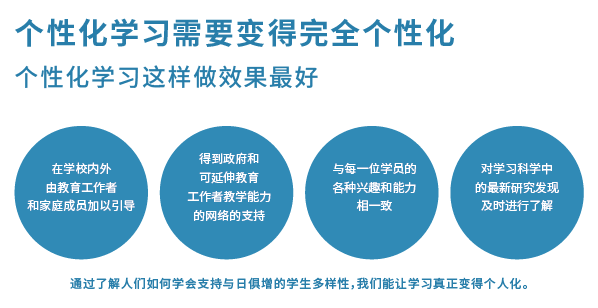
Editor's Note: Personalized learning with technology is what education companies want to achieve. In the United States, from the iNACOL Symposium in 2009, we began to explore how to use a hybrid approach to achieve personalized education, combined with educational technology to achieve better teaching results. Now that seven years have passed, what has changed in the actual teaching situation in the United States, and what is still waiting to be changed. The actual application of the United States may provide a reference for the country.
Signs of progress
1. Clarify the definition of mixed learning that helps achieve personalized instruction.
The Christensen Institute gives the most widely accepted definition of blended learning, which emphasizes integration, speech, and choice. Founded 4 years ago, Learning Accelerator is designed to promote blended learning, and the agency has created a framework that clarifies how data can be used to personalize learning and the ability to determine learning progress.

2. The school training model changes.
More and more networks and regions are combining personalized learning with project-based learning to make personalized skills more pragmatic, relevant to the real needs of society, and often supported on a team-by-team basis.
A lot of work for individual teachers can meet the needs of individual students, but more and more outstanding schools advocate a common approach and multi-year progress through close teamwork. More school district schools are joining networks such as NAF and the New Tech Network to share common practices, curriculum, and tools.
3. Teaching platform and socialization.
The platform has changed the US economy and has begun to make personalized learning, including mashups, social learning, and student support, easier to implement.
4. A large number of adaptive learning aids appear.
Adaptive learning tools (such as Dreambox, i-Ready), collaborative authoring tools (Google docs, Office 365), open source resources (CK-12, Gooru), and a host of mobile apps are greatly expanding learning opportunities.
5. Micro-certificate.
A recent paper discussed micro-certifications that indicate that someone has demonstrated a certain skill set. As a progress tracking and signaling system, micro-certifications are becoming more and more popular in the field of education because they provide a promising approach to personalized, competency-oriented professional learning.
There is still no obstacle to overstepping
1. The so-called personalization is based on the same teaching framework, which is inherently narrow.
Most personalization is differentiated on top of a teaching framework. We are just beginning to understand the impact of a broader framework that takes into account the cognitive and poverty-causing injuries. A new report from Digital Promise presents a broader framework.

2. There is still a disconnect between assessment and training.
While most students benefit from adaptive, embedded curriculum, teacher scoring, and some benchmarking, it is still difficult to apply these feedbacks to easy-to-use real-time information. That is to say, there is still a disconnect between feedback and real-time teaching.
3. Lack of metrics for emotional development and creativity.
For social emotional learning and creative thinking, we don't have a common vocabulary and measurement. We can use new methods to "find".
4. Limitations of external policies.
Federal and state policies (grants, assessments, accountability) and college admissions policies have strengthened traditional practices and reduced incentives for learning progress by ability.
5. Technical difficulties.
Developing a school model that uses a personalized learning approach poses a huge challenge in design; matching it to an integrated technology system is still a daunting task. (A platform-centric school network will help solve this problem.)
6. Community involvement.
Education leaders need new protocol production tools to support the pilot and scale of innovation practices. In the following areas, we need stakeholders to participate better:
What graduates should know and what they can do;
Why, how, and for what purpose, use technology, and how we protect privacy;
Community ambitions and community-focused learning options;
How do we monitor growth and how students make progress.
We have made great progress in the past five years, but we are still in the early stages of the personalized learning revolution.
Reborn PLLA filler can be used to solve eyes' problems such as dark circle,eye bags,crow's feet,fine lines,etc.
The particle size of Reborn PLLA Dermal Filler is 3-10 microns.It is very safe to use around the eyes.
Reborn PLLA Hydrogel can solve facial skin problems such as redness,large pores,acne marks,fine lines,crow's feet,smile lines,etc.It can resolve 7 big problems at the same time, It can make the skin white and tender, replenish lost water and collagen, awake the cell regeneration function, repaire the withered cells of the skin, shrink of enlarged pores, reduce discoloration, patch of acne pits.
Rimless Industry Co., Ltd. (RIMLESS) is devoted to the global brand operating and integrating, sale and after-sale services of high-end medical devices, regenerative aesthetic products, cosmetics and beauty tools.
Facial Filling Treatment,Plla Wrinkle Dermal Fillers,Injectable Hyaluronic Acid Pla,Wrinkle Reducer Fillers
Rimless Industry Co.,Ltd. , https://www.rimlessmedbeauty.com